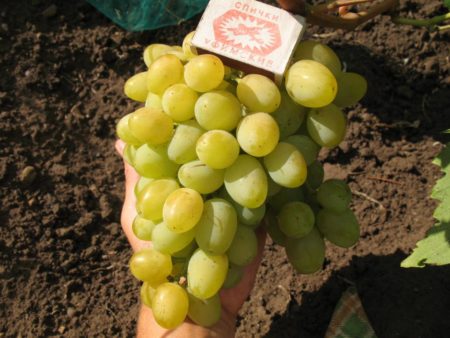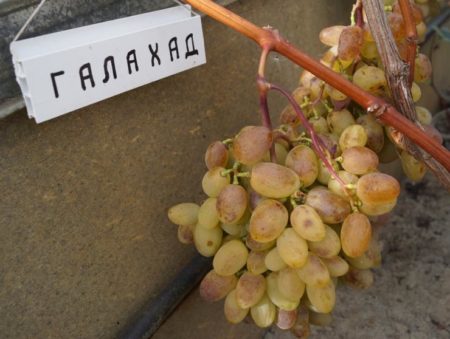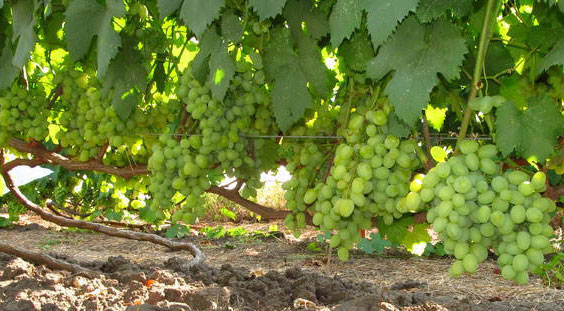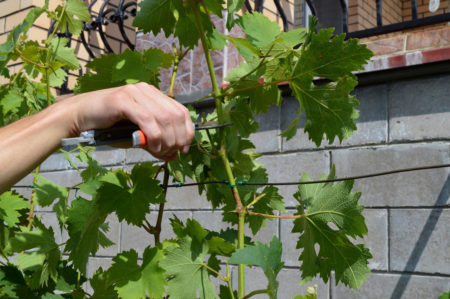Russian variety with a steadily growing rating. Having appeared on the market in 2007, Galahad steadily expands its circle their fans. Hybrid characteristics are suitable for temperate viticulture areas. Work on the hybrid was carried out in VNIIViV Ya.I. Potapenko, as genetic material, breeders used Delight, Talisman, and Muscat Delight.
Content
Description and characteristic
 The form is very promising, early. Berries (up to 70%) ripen in 100 days. Harvest dates depend on climatic conditions:
The form is very promising, early. Berries (up to 70%) ripen in 100 days. Harvest dates depend on climatic conditions:
- southern areas - July (end of the month);
- Central and more northern regions - August (1-2 decades).
The bush is characterized as vigorous. In good conditions, the length of the vine can reach 40 meters. Quality care guarantees the bush a long life. According to forecasts, the productive life of Galahad can last from 130 to 150 years.
The cluster is characterized by a regular conical shape, slightly loose structure, weight from 500 g to 1200. The characteristics of the berries are summarized in the table.
| Name | Description |
| the form | oval, oval-ovoid |
| color (ripe berries) | amber yellow |
| color (unripe berries) | milky green |
| raid | present, waxy, gray-blue |
| skin | brown spots are normal, strong, edible |
| taste (rating) | 4.3 (five-point system) |
| taste (description) | sweet, sweet |
| cracking | absent |
| attitude towards transportation | sustainable |
A table grape variety is grown for sale and fresh. From the fruits you can get juice, use them in home winemaking. From ripe berries, jam is cooked for the winter.
Advantages
 The shoots have a strong growth force, with good care for the season, grow by 2 m. There is no need to have pollinating varieties in the vineyard, the flowers of the Halahad variety are bisexual. Wood and kidneys withstand frosts of -25 ° C. The undoubted advantages of a hybrid form:
The shoots have a strong growth force, with good care for the season, grow by 2 m. There is no need to have pollinating varieties in the vineyard, the flowers of the Halahad variety are bisexual. Wood and kidneys withstand frosts of -25 ° C. The undoubted advantages of a hybrid form:
- precocity;
- productivity;
- immunity.
disadvantages
Preventive treatments for fungal infection and phylloxera are needed. It is necessary to control the degree of illumination of the vine in order to maintain a beautiful, bright color of the berries. Soil composition may affect yield. Delay in harvesting may lead to partial loss. Overripe berries are prone to shedding.
Features of cultivation and care
Galahad is propagated by cuttings and seedlings. The survival rate of the cuttings is high. Seedlings should be chosen annuals, with light brown wood and light green shoots. There should be no obvious damage or signs of mold on the roots.
Landing
 Galahad is not afraid of the wind, but protection in the form of a brick wall will benefit. Brick, heating during the day, emits heat at night, this improves the microclimate. The construction should not obscure the vine during the day. The hybrid ripens and stains faster in sunny areas.
Galahad is not afraid of the wind, but protection in the form of a brick wall will benefit. Brick, heating during the day, emits heat at night, this improves the microclimate. The construction should not obscure the vine during the day. The hybrid ripens and stains faster in sunny areas.
Before planting, assess the level of groundwater. The lower the level of their occurrence, the better. Galahad seedlings are planted on bulk ridges if the waters come close to the surface (<2 meters). The composition of the soil plays a small role. The hybrid can grow on soils of different types (peat, sand, loamy). Galahad does not tolerate soil salinization.
Beginning winegrowers better plant Galahad in the spring (April, May). The adaptation of seedlings takes up to 2.5 months. In the absence of experience, it is difficult to calculate the timing of autumn planting. Spring planting has more advantages.Seedlings over the summer are fully adaptable, build up a good root system, and prepared ones leave for the winter.
Use:
- pebbles;
- construction battle;
- expanded clay.
The backfill soil is improved by adding humus, ash or fertilizer to the garden soil. Ashes per well need about 3 liters. It can be replaced with potassium sulfate (500 g), superphosphate (600 g). The entire area of the trunk circle after planting is watered. One seedling takes up to 6 buckets of water.
Care
 During the growing season, grapes need water, fertilizers, pruning, garter to the trellis. A young shoot is tied to the wire at an angle for better lighting, laying straw under the bottom. During the first years (4-5), only forming pruning is performed. Focus on a load of 30-35 eyes per bush. 6 to 8 buds are left on the fruiting shoot.
During the growing season, grapes need water, fertilizers, pruning, garter to the trellis. A young shoot is tied to the wire at an angle for better lighting, laying straw under the bottom. During the first years (4-5), only forming pruning is performed. Focus on a load of 30-35 eyes per bush. 6 to 8 buds are left on the fruiting shoot.
In the summer, the list of green jobs is as follows:
- control the length of the vine, pinch it if necessary;
- removal of weakened shoots;
- pruning leaves.
In autumn, after leaf fall in 2 stages, forming pruning is performed. In the first run, tops and weak branches are cut out. After 2 weeks, they begin their main work:
- all old shoots located under the 1st wire are cut out from the old sleeves;
- at branches tied to the 2nd wire, side stepsons are cut out;
- shorten the remaining shoots by 10%.
Galahad bushes are rejuvenated once every 8 (10) years. In the northern and central regions, the form is grown as a cover culture. In autumn, near-stem circles are cleaned, loosened, covered with a layer of mulch. The vine removed from the trellis is laid on the ground or in dug trenches. Cover it with any air-conducting material. The best shelter for the winter is considered lapnik.
Disease prevention
The danger is root rot. Its cause is waterlogged soil. With properly organized watering, there are no problems. Immunity to fungal infections is stable. To maintain the health of the bushes, 3 treatments per season are enough:
| Time | Compositions | Concentration |
| spring, 2 weeks after removal of the shelter | Bordeaux fluid solution | 3 % |
| leaves bloomed | Bordeaux fluid solution | 1 % |
| flowering is over | colloidal sulfur (aqueous solution) | 30 g per 10 liter bucket |
Instead of Bordeaux liquid, grapes can be sprayed with biological fungicide. Their selection is wide. The most common preventive agents for fungus:
- Fitosporin M;
- Gamair;
- Bayleton.
For therapeutic purposes, more powerful chemicals are used: Quadris, Skor.
Pests
Galahad suffers from phylloxera. They are saved from the sheet form by treatments with Zolon, Actellik or Confidor-Maxi preparations. Root aphids are almost impossible to destroy. Experienced winegrowers solve the problem by planting Galahad on phyloxere-resistant varieties:
- Danko;
- Fiery;
- Amateur.
Wasps do not damage berries; you need to protect the crop from invasion of birds. Effectively apply a fine mesh.
| Phylloxera prophylaxis | Processing period |
| carbamide solution 7% | Spring |
| nitrafen | autumn |
| Salt solution 200 g per 10 l | every 2 weeks in summer on leaves and shoots |
Reviews
Andrey, Kamyshin
I can safely recommend Galahad to winegrowers from the northern regions.According to its characteristics (resistance to disease, pollination, ripening, sugar accumulation) it is the most stable form, I can not put on par with it any other variety.
Sergey, Belokurikha
The bush is three years old, the signaling was last year. I cut 10 bunches, all decent, correspond to the description. Vine ripening is excellent, almost 100% (full length). There was no cod, berries from wasps were not damaged, they can hang on the vine for a long time. I liked the taste. The form is suitable for cultivation in our region. This year, by the end of August, sugar gained 16%, if you're lucky with the weather, I think it will get it again.
Anton, Stavropol Territory
Galahad is not in the top of my favorites, for me it is a medium grade. The clusters are not large, the size of the berries is average, there are no complaints about the taste - harmonious. Plus - stable fruiting in stepsons. A decent harvest, all the clusters have time to ripen.
Cyril, Pyatigorsk
I do not consider Galahad a super early variety. To reduce acidity in taste, he needs to hang longer. I have clusters after ripening hang another week. The taste after this is noticeably better, the berries become sweet, sourness is weak. The weight of the clusters is different - from 500 g to a kilogram. The load on the bush is 25-30 bunches.




 Non-covering winter-hardy grape varieties for Moscow region
Non-covering winter-hardy grape varieties for Moscow region How to keep the vine in winter
How to keep the vine in winter When can I transfer grapes to another place in the fall
When can I transfer grapes to another place in the fall How to cover and prepare grapes for the winter in the suburbs
How to cover and prepare grapes for the winter in the suburbs